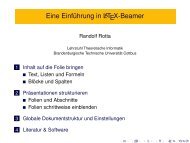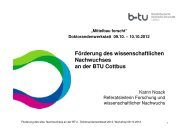Multilevel Graph Clustering with Density-Based Quality Measures
Multilevel Graph Clustering with Density-Based Quality Measures
Multilevel Graph Clustering with Density-Based Quality Measures
Create successful ePaper yourself
Turn your PDF publications into a flip-book with our unique Google optimized e-Paper software.
2.4 Fundamental <strong>Clustering</strong> Strategiesabout the vertices. In such cases vertices lying far away are expected to have weakerconnectivity. For example the number of direct flights between airports is mainlyinverse proportional to their distance. Now consider a graph of airports connectedby edges when they have direct flight connections like shown in Figure 2.2. Theedges are weighted by the frequency of direct flights. <strong>Graph</strong> clustering methodsthen would indirectly just discover the distance as building component of clusters.However some airports might have exceptionally strong connections because theyfor example have economical ties or belong to the same country. In order to studysuch structures it would be necessary to remove the influence of the geographicaldistance. This might be achieved by integrating this distance into the volume model.More abstractly the volume is derived from a suitable chosen vertex (dis)similaritymeasure. Then weak connections are expected between dissimilar, high-distance vertices.In reverse similar, low-distance vertices are expected to be strongly connected.In this context the density-based graph clustering can be interpreted as a search forvertex groups being actually stronger connected than their similarity suggests.2.4 Fundamental <strong>Clustering</strong> StrategiesThis section tries to give an overview about clustering methods. Many methods combineseveral basic approaches. These components are provide useful ideas for thedesign of new algorithms. From a very short review of the literature common, oftenused components were identified. They can be broadly classified into constructingcomponents, directing components, and meta-strategies. Constructing componentsgenerate a clustering. They contain for example dissection, subdivision, agglomeration,and refinement algorithms. Directing components control how the clusteringis generated. This includes selection criteria and randomization methods. Finallymeta-strategies combine constructing components. Examples are recursive subdivision,multi-level refinement, basin hopping and genetic algorithms. In the followingtext the literature is shortly summarized. The next three sections describe basicdirecting and constructing components, and meta-strategies.Table 2.1 summarizes the graph clustering algorithms for the modularity measure.Most information was derived from reviews of Danon et al. [18] and Newman [56].The entries are classified by their basic strategy and the third column summarizessome details. A few publications appear several times as they incorporate differentstrategies.Other algorithms exist, which were not designed to optimize the modularity measure.These include algorithms for the minimum cut partitioning problem, which isan important topic in load balancing of for example computational fluid dynamicsimulations. In this context a lot of research is already done on graph clusteringalgorithms. Therefore this literature might contain useful ideas. A historic reviewof graph partitioning methods can be found in [14]. Table 2.2 summarizes somerelated methods.17






